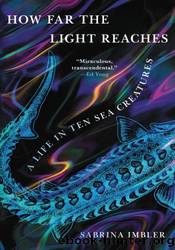How Far the Light Reaches by Sabrina Imbler

Author:Sabrina Imbler [IMBLER, SABRINA & Ban, Simon]
Language: eng
Format: epub
Published: 2022-12-06T00:00:00+00:00
We Swarm
Two Aprils ago, a humpback whale stranded on Jacob Riis Beach in New York and died belly-up: white fins splayed in the sand like a snow angel, grooved throat mounded as if still holding a gulp of air. Its death made the local papers. The 28-foot-long whale was the yearâs first reported stranding in the area. Its body appeared pristine, at least as far as dead whales go. A week later, the whale was buried, and its beachfront burial also made the local papers.
When I read the whaleâs brief obituary, I squinted at the photo, trying to figure out where on Jacob Riis it had stranded. I go to Riis Beach often, and I wanted to place the whale somewhere on that landscape. I wanted to know if it had died somewhere I had walked, or, in the future, I wanted to walk across the stretch of sand where it had died. But the picture was placeless, the whale a blip on a stretch of empty sand whose only landmarks were a few distant dunes and a weathered skyline of wood pilings.
I have seen many creatures stranded on Riis Beach that were not large or notable enough to garner press coverage. I remember the holographic sheen of a still-inflated man-of-war, shining like a bubble on the sand. The hollow, chestnut husk of a horseshoe crab, a chunk missing from its side and a pristinely reticulated tail that shuddered when I picked it up. A motionless mole crab with a belly full of tiny, sherbet-colored eggs. These animals died as the whale didâcarried too close to shore by warm waters or riotous currentsâbut their strandings would only make the news if they occurred en masse: a parade of men-of-war in the surf, hordes of overturned horseshoe crabs, a mountain of molted mole crab shells gently lapped by waves. In the headlines, these creatures never âstrandedâ; rather, they âwashed up.â Why was that? Perhaps stranding suggested the creature was worth noticing, was worth saving.
The National Oceanic and Atmospheric Administration, or NOAAâthe governing body of matters like theseâhas a dedicated network that observes the strandings of marine mammals and sea turtles. There is a bureaucratic system for people to report strandings, people and agencies to call as if they were next of kin. There is even an app for whales and dolphins. There is no stranding network for smaller creatures without faces, like mole crabs or men-of-war, whose bodies erase themselves by washing away or dissolving back into sand.
Several years ago in September, I saw shimmering heaps of gelatinous blobs strand on the shores of Riis Beach. Everyone who went near the water that day noticed the blobs, including my friends, my crush, my crushâs crush (who, sadly, was not me). But they were reluctant to inspect the blobs, which had amassed in nubbly, sparkling dunes. âIs it alive?â someone asked. âI donât want to get stung,â another replied, and they walked away from the water to spread their towels and single, battered umbrella far away from the lapping waves.
Download
This site does not store any files on its server. We only index and link to content provided by other sites. Please contact the content providers to delete copyright contents if any and email us, we'll remove relevant links or contents immediately.
| Cell Biology | Developmental Biology |
| Entomology | Marine Biology |
| Microbiology | Molecular Biology |
| Biostatistics |
Sapiens: A Brief History of Humankind by Yuval Noah Harari(14322)
The Tidewater Tales by John Barth(12627)
Mastermind: How to Think Like Sherlock Holmes by Maria Konnikova(7281)
Do No Harm Stories of Life, Death and Brain Surgery by Henry Marsh(6908)
The Thirst by Nesbo Jo(6882)
Why We Sleep: Unlocking the Power of Sleep and Dreams by Matthew Walker(6659)
Life 3.0: Being Human in the Age of Artificial Intelligence by Tegmark Max(5520)
Sapiens by Yuval Noah Harari(5328)
The Longevity Diet by Valter Longo(5044)
The Body: A Guide for Occupants by Bill Bryson(5033)
The Rules Do Not Apply by Ariel Levy(4912)
The Immortal Life of Henrietta Lacks by Rebecca Skloot(4552)
Animal Frequency by Melissa Alvarez(4431)
Why We Sleep by Matthew Walker(4395)
The Hacking of the American Mind by Robert H. Lustig(4342)
Yoga Anatomy by Kaminoff Leslie(4336)
All Creatures Great and Small by James Herriot(4277)
Double Down (Diary of a Wimpy Kid Book 11) by Jeff Kinney(4244)
Embedded Programming with Modern C++ Cookbook by Igor Viarheichyk(4144)
